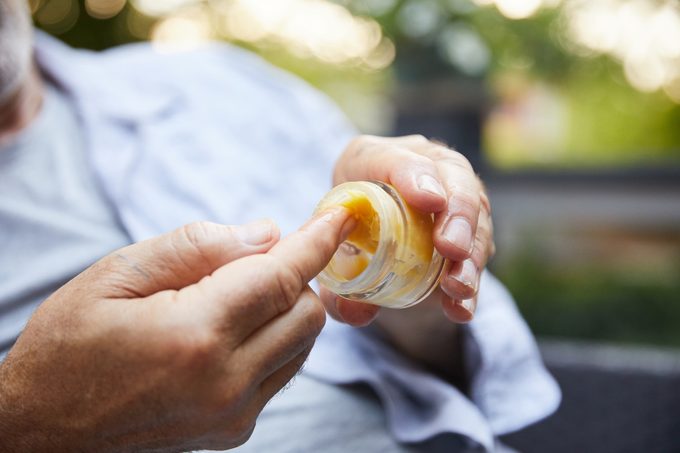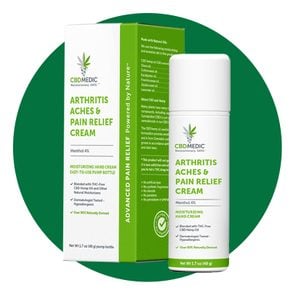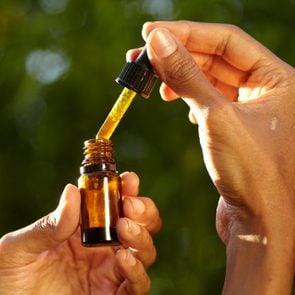What to Know About Using CBD for Arthritis
Updated: Mar. 02, 2021
Our editors and experts handpick every product we feature. We may earn a commission from your purchases.
Does CBD for arthritis work?
Managing the pain and stiffness of arthritis can be a challenge, so many people are turning to cannabidiol (CBD) for relief. In a poll conducted by the Arthritis Foundation, 29 percent of respondents said they were currently using a CBD product to deal with symptoms and many more had used it previously or were considering it. (Here’s what to know about CBD oil for pain.)
Participants in a poll conducted by Project CBD, a California nonprofit that promotes CBD research, said CBD was useful for arthritis, among other conditions. There’s also anecdotal data and historical records documenting CBD’s effectiveness, says Martin A. Lee, co-founder and director of Project CBD and author of Smoke Signals: A Social History of Marijuana–Medical, Recreational, and Scientific.
“It’s not an overstatement to say almost by definition that cannabis [which contains CBD] is good for inflammatory disorders,” Lee says.
Here’s what we know about CBD and arthritis, be it osteoarthritis, rheumatoid arthritis, or another form of the condition.
What is CBD, exactly?
CBD is one of two main active ingredients in cannabis or marijuana plants, but not the one that makes you high. That’s delta-9-tetrahydrocannabinol (THC), which is generally not found in CBD-specific products, or at least not found in high quantities. (Here’s more on the differences between CBD vs. THC.)
CBD can also be extracted from the hemp plant, which is similar to the marijuana plant but has much lower levels of THC. The 2008 Farm Bill allowed farmers to grow hemp as long as it contained no more than 0.3 percent THC. (Also, learn the difference between CBD oil vs hemp oil.)

What the science says
The scientific evidence for CBD’s impact on arthritis consists mostly of animal and laboratory studies, although there have been a few human studies.
A 2015 study in Arthritis Care & Research reviewed four small studies in humans and concluded there was only modest evidence that CBD may help rheumatic diseases. And a 2018 study in people with osteoarthritis-related knee pain found that CBD was really no better than a placebo, though that study, which appeared in Osteoarthritis and Cartilage, hasn’t been vetted by other scientists and only lasted 12 weeks.
(Here’s the difference between rheumatoid arthritis vs. osteoarthritis.)
Animal and lab studies
Studies done in animals have been more encouraging, including one in the European Journal of Pain which found that CBD gel decreased joint inflammation and pain in arthritic rats.
There have been other studies like that one, but often using higher doses than you would normally use in people, says Jahan Marcu, founding partner of cannabis consultancy Marcu & Arora and editor-in-chief of the American Journal of Endocannabinoid Medicine.
There is also evidence that stimulating receptors in the body’s endocannabinoid system may impact pain, but that doesn’t mean CBD will do the same thing, adds Marcu, while adding that these are “promising leads.”
(Here’s what you should know about CBD and inflammation.)
Is CBD safe?
According to the National Institute on Drug Abuse, CBD is generally safe though it may cause drowsiness, lightheadedness, and, in rare cases, liver damage.
One important thing to know is that it can interact with medications that people with arthritis often take, including corticosteroids, a class of drugs used to suppress immune reactions and used to treat asthma and allergic reactions; naproxen (Aleve); celecoxib (Celebrex); and certain antidepressants.
The National Library of Medicine keeps a list of potential drug interactions, but make a note to also talk to your doctor before trying CBD.
Is CBD legal?
This is a murky area. In addition to California, which was the first to legalize the compound, CBD is legal in 35 states plus the District of Columbia, Guam, Puerto Rico, and the U.S. Virgin Islands, according to the National Conference of State Legislatures.
But on the federal level, it’s still considered a controlled substance, although CBD products that come from hemp are not.
At this point, the Food and Drug Administration (FDA) has only approved one CBD-derived drug, Epidiolex, and that’s for rare forms of childhood epilepsy. The FDA does not regulate the CBD products sold on the Internet and elsewhere.
Using CBD for arthritis
The Arthritis Foundation has issued guidance on using CBD for arthritis. First, it advises that you do not stop any disease-modifying anti-rheumatic drugs (DMARDs) you may be taking for inflammatory forms of arthritis like rheumatoid arthritis. If you try CBD, start in low doses and increase in small weekly increments if needed.
Do research about the companies and products. They should be batch tested for purity, strength, and safety by an independent lab. To start, these CBD creams for arthritis come expert-recommended for quality and safety.
Types of CBD products
One of many decisions you’ll have to make before trying CBD is what form to use. There are three main ones:
- Full-spectrum CBD: This contains all of the components of the hemp plant (Cannabis sativa), including CBD and also small traces of THC and terpenes, which are plant compounds.
- Broad-spectrum CBD: This includes all of the components, including CBD but not THC.
- CBD isolates: This is the purest form of CBD and should only contains CBD.
Experts believe full-spectrum or broad-spectrum products are more effective when taken at lower doses because they include additional plant components that will have synergistic effects above and beyond effects from individual ingredients. This is known as the “entourage effect.”
You’ll also have to choose between topical creams and topical oils, oils that are ingested, gummies and other edibles, capsules or tablets, and vaping. Check out the best CBD oils for arthritis that experts recommend.
Topical and sublingual (under the tongue) formulations often work quickly while oral formulations like CBD edibles, CBD capsules, and CBD gummies can take 30 minutes or longer to kick in. Vaping is faster still but it’s been linked with lung damage, including the EVALI (e-cigarette or vaping use-associated lung injury) outbreak.
(Learn more about the risks and benefits of CBD vape oil.)
What to look for in a CBD product
Ideally, find a medical dispensary to help you find the right product and the right dosing. (There are no guidelines on what dose is right for what; much of it is trial and error.) If not, you’ll have to do a little research on your own.
“There are some companies that use science to inform their products. The vast majority do not,” says Marcu. To that end, make sure the company’s products have a certificate of analysis (COA) from an independent third-party lab.
Also, be wary of product makers claiming a product can benefit a particular condition. “That’s more a symptom of the unregulated market,” says Lee.
The Rheumatoid Arthritis Support Network recommends Spruce Natural Labs which sells only full-spectrum CBD oil tinctures. Spruce products contain a small amount of THC. The Network said they’ve found combining the sublingual products with cream directly to the joint to be the most effective.
Next, learn about CBD for sleep.



